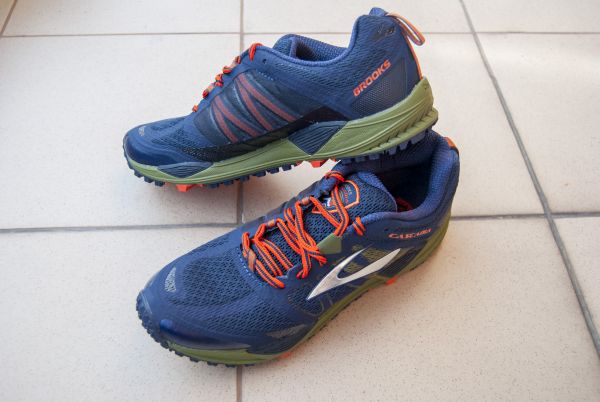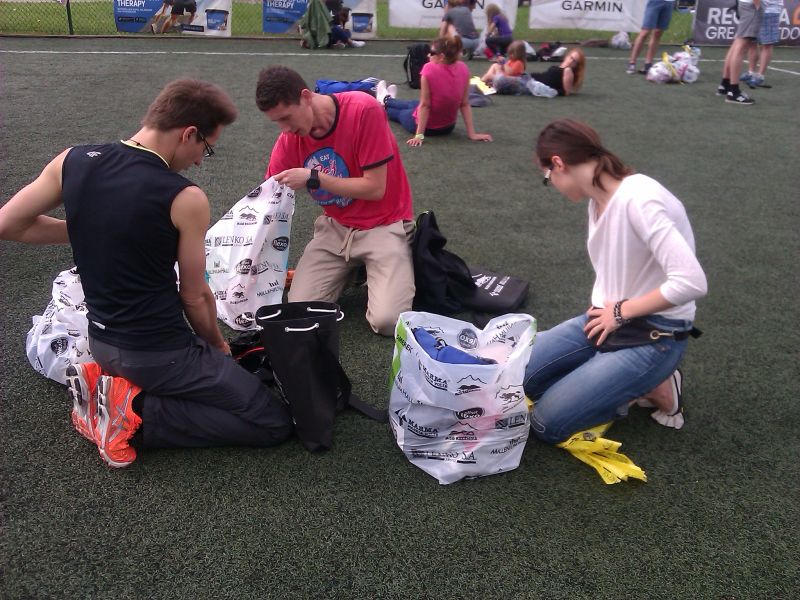20 hours running… surrounded only by mountains and forests, and you only have what’s on your back … Right, let’s see what do you have there? Ooohh, a bunch of crap indeed – and where’s the really useful stuff? Look what I packed!
LET’S PACK YOU UP FOR ULTRA!
Are you preparing for a mountain race or a longer, lonely run in the mountains? Is it your first time? You’re probably wondering what will be most useful? I will try to help you – I have some experience.
SHOES
You probably run for some time now, so you know how to choose running shoes – I’m not going to talk about sizes then. However, with mountain running it’s good to choose the shoes accordingly to the conditions. They must hold the foot well as you’ll run on various surfaces and nothing must slide or slip. The shoe sole is also very important – think in what conditions you’ll run. There are universal outsoles (eg. Brooks Cascadia) that can handle most of the conditions and won’t wear out too fast even on asphalt fragments – such shoes are good for standard conditions for most of the year. However, there are races that take place in heavy mud or snow. In such a case, you should choose a more aggressive oustole (most Salomon or Inov-8 shoes have such). Yet another outsole is needed for ice – the one with metal spikes sticking out of the sole.
The upper in the mountain running boots should hold the foot very well and be resistant to numerous lateral abrasions on rocks and roots. It’s also worth to look for the protected toe-cap – after many many kilometers, you’ll be grateful for this extra protection for your precious fingers.
CLOTHES
I happened to run 2 hours with the absolutely torn outer sides of both feet … after this adventure I started running in 5-finger socks, which solved the problems, but experience „carved” into memory…
Bad socks may skin off your feet, so I recommend to choose well and test even better. I assume you know that you need to dress appropriately for the weather? You must also bear in mind that the conditions in the mountains can change suddenly and that you’ll spend some time there. Take comfortable clothes – really comfortable and proven. The point is that after 4 or more hours of running, you don’t get any abrasions, which will make every step a living hell. This especially applies to running shorts – bad shorts can cause abrasions on the thighs.
The jacket should be as light as possible – in the end all of it you’ll carry on you back the whole time. The best is a thin windbreaker, which will take up little space. This is actually a must have – if you need something thicker/warmer, it’s a matter of your individual feeling of temperature.
I always bring at least two buffs – instead of a hat. It takes up almost no space, you can tie it on your wrist or cover your neck, or even tear it into strips in case you have to cover your wound or tie something that fell apart on the way.
FOOD AND LIQUIDS
Chocolate, banana, peanut, cranberry… so what that I have 4 different bars in pockets. My stomach rebels against anything sweet, but would love to have anything salty!
Don’t take only sweets, because you never know. Every run is different, you have different conditions, and your stomach can have it’s own moods. You won’t win with your stomach… Make sure to have something salty, not only bars and cookies. This can save your life ;-)
Plan your food so that you have enough till the next refreshment point (best to have a bar or two more – just in case). I take 500 ml of fluid for every hour of running between points and watch eating every 40-50 minutes. People have different needs, so adjust it to you – for me this works perfectly.
In the case of a long trail run, take even more and find out where you can refill your stocks – especially water. The food is lighter, so you can safely pack some bars, tortillas, sandwiches or dried fruits (these are the lightest and most energetic). Water will weigh the most, but without it you won’t get far.
BACKPACK/JACKET/BELT
I’ve seen runners on the ultramarathons who were just having running belts … but if you read it, I assume you think a bit more conservatively. It may be better to choose a backpack or a vest. In my experience, 12L is enough for every run under 100 km. Remember that along the way you have refreshment points and deposits (longer distances).
POLES
Precisely – take them or not? For an easier (or shorter) run, do not even fool around, but for a harder ultra (very long, tedious, with high total elevation gain) take them if you know how to use them. Running with poles is a completely different story – I learned it myself during the last competition. Even though I’ve been training running with poles, the race showed things i never noticed before.
OTHER
Sports watch is the thing most people use and I don’t even have to write about it. Of course, I didn’t put it on the mandatory list because I know people who do well without this gadget – a map and route profile is all you really need. Things look different with the first aid kit – I never used it… fortunately! Yet, I always have it with me, even the most basic – elastic bandage, sterile compress, band-aid. For a longer run – Sudocrem (for abrasions), Apap and patches for imprints. For a solitary trail run it’s a must.
If a part of the race takes place at night, the organizer will require you to have a headlamp. I recommend you stick to it and take with you always, even if you do a solitary run and plan to return in 2-3 hours. You never know what happens in the mountains, so take care of your own safety.
On long mountain runs, I usually wear compression calf sleeves, sometimes also compression pants. Compression can lengthen your ability to stay in motion and protect you from potential injury. It’s worth thinking about it, but it’s an individual issue.
DEPOSITS
I believe that you already know a bit about running in the mountains, but just in case, I’ll explain what a deposit is (for those crazy people who read this article in the evening, before the race they signed on at the spur of the moment ;)). Well, before the start you can leave (if the race regulations allow it) a bag at the start with prepared spare equipment. On long runs, the organizer usually provides at one (or more) refreshment points a deposit – this is where you can access the bag. You can pack everything you don’t want to carry on your back the whole time, but can be useful along the road: spare clothes (jacket, sweatshirt, socks, new clothes), favorite food, poles (if you want to have them later on the tour), powerbank, gloves, shoe gaiters, etc. No water is needed, as it’s always available at the point. Food as well, but you might want to have your favorite delicacies that will make you feel better.
CHECKLIST
Below you’ll find a list that has proven many times in my case and takes into account most of the obligatory gear required by organizers on most trail races. Compare it with the requirements of the race in which you participate. Sometimes it’s in very specific conditions and the organizer wishes you to have additional equipment (eg. obligatory long gaiters or waterproof gloves).
LONGER ULTRA RUN (80+ KM)
| OBLIGATORY EQUIPMENT | RECOMMENDED EQUIPMENT |
|
Recommended:
Optional:
|
SHORTER ULTRA RUN (50-80 KM)
| OBLIGATORY EQUIPMENT | RECOMMENDED EQUIPMENT |
|
Recommended:
Optional:
|
INDIVIDUAL TRAIL RUN
| OBLIGATORY EQUIPMENT | RECOMMENDED EQUIPMENT |
|
Recommended:
Optional:
|
If you find think article interesting, share it with others using the social media buttons below the text. If you don’t want to share, maybe at least like it? :)








